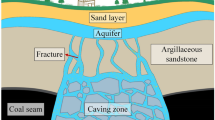Abstract
A numerical solution, using the finite difference method, and based on a porothermo-elasto-plastic formulation for dual-porosity one-dimensional consolidation has been presented. The model is fully coupled to ensure the interactive behavior of fluid flow, heat flow and solid deformations in the conservation of momentum, mass and energy equations. A bi-linear stress-strain relationship is used to accommodate elastoplastic deformation behavior. A double effective stress law, proposed by Elsworth and Bai (1992), is applied to describe constitutive relationships among the stresses, pressures and temperatures. In order to examine the dual-porosity and thermal effects on the soil consolidation individually, isothermal and non-isothermal consolidations for a dual-porosity column are analyzed. In comparison to the single porosity approach, the present study shows that the pore pressure dissipation is faster and Mandel's effect (Mandel, 1953) is more pronounced at early times of the source disturbance for dual-porosity consolidation. One of the significant parameters affecting the dual-porosity consolidation is the fracture spacing (fracture density); the smaller the fracture spacing, the faster the column drainage.
Similar content being viewed by others
References
Aifantis, E.C.(1977)Introducing a multi-porous medium,Developments in Mechanics, 9, 201-211.
Aifantis, E.C.(1979)On the response of ssured rocks,Developments in Mechanics, 10, 249-252.
Aifantis, E.C.(1980a)On the problem of diffusion in solids,Acta Mechanica, 37, 265-296.
Aifantis, E.C.(1980b)On Barenblatt 's problem,Int.J.Engng.Sci.,18, 857-867.
Bai,M.(1999)On equivalence of dual-porosity poroelastic parameters,J.Geophy.Res., 104 (B5),10461-10466.
Bai, M.and Elsworth, D.(2000)Coupled processes in subsurface deformation, flow,and transport,ASCE Press,ISBN 0-7844-0460-7.
Bai, M.and Roegiers, J.-C.(1994)Fluid flow and heat flow in deformable fractured porous media,Int.J.Engng Sci.,32 (10)1615-1633.
Bai, M.and Abousleiman,Y.(1997)Thermoporoelastic coupling with application to conso-lidation,Int.J.Numer.Anal.Methods Gemech.,21, 121-132.
Barenblatt, G.I., Zheltov, I.P.and Kochina,N.(1960)Basic concepts in the theory of seepage of homogeneous liquids in ssured rocks,Prikl.Mat.Mekh.,24, 852-864.
Biot, M.A.(1941)General theory of the three dimensional consolidation,J.Appl.Phys.,12, 155-164.
Charlez, Ph.A.(1991)Rock Mechanics, Vol.1,Theoretical fundamentals,Technip,Paris.
Coussy,O.(1989)A general theory of thermoporoelastoplasticity for saturated porous materials,Transport in Porous Media, 4, 281-293.
Desai, C.S., Kuppusamy,T., Koutsoftas, D.C.and Janardhanam,R.(1979)A one-dimensional nite element procedure for nonlinear consolidation,In:Proc.3rd Int.Conf. Num.Meth.Gemech.,Aachen,pp.143-148.
Dykhuizen, R.C.(1990)A new coupling term for dual-porosity models,Water Resour.Res., 26, 351-356.
Elsworth, D.and Bai,M.(1992)Coupled flow-deformation response of dual porosity media, J.Geotech.Eng.,ASCE,118, 107-124.
Khaled, M.Y., Beskos, D.E.and Aifantis, E.C.(1984)On the theory of consolidation with double porosity-III.a nite element formulation,Int.J.Num.Anal.Meth.Geomech.,8, 101-123.
Mandel,J.(1953)Consolidation des sols,Geotechnique, 3, 287-299.
Moutsopoulos, K.N., Konstantinidis, A.A., Meladiotis, I.D., Tzimopoulos, C.D.and Aifantis, E.C.(2001)Hydraulic and contaminant transport in multiple porosity media, Transport in Porous Media, 42, 265-292.
Smith, D.W.and Booker, J.R.(1993)Green 's functions for a fully coupled thermoporoelastic material.Int.J.Num.Anal.Meth.Geomech.,17, 139-163.
Warren J.E.and Root P.J.(1963)The behavior of naturally fractured reservoirs,Soc.Pet. Eng.J.,Trans.AIME, 228, 245-255.
Wilson, R.K.and Aifantis, E.C.(1982)On the theory of consolidation with double porosity, Int.J.Engng.Sci.,20, 1009-1035.
Terzaghi,K.(1923)Die Berechnung der Durchassigkeitsziffer des Tones aus dem Verlauf der hydro-dynamischen Spannungsercheinungen,Sitzungsber.Akad.Wien Math-Naturwiss. Kl.Abt.,2A,132, 105.
Zhang,H., Bai,M., Abousleiman, Y.and Roegiers, J.-C.(1999)An elastoplastic analysis of non-isothermal consolidation,Int.J.Num.Anal.Meth.Geomech.,23, 1535-1557.
Zhang,J.(2002)Dual-porosity Approach to Wellbore Stability in Naturally Fractured Reservoirs,Ph.D.Dissertation,The University of Oklahoma,2002.
Zimmerman, R.W., Chen,G., Hadgu, T.and Bodvarsson, G.S.(1993)A numerical dual-porosity model with semianalytical treatment of fracture/matrix flow, Water Resour. Res.,29, 2127-2137.
Author information
Authors and Affiliations
Rights and permissions
About this article
Cite this article
Zhang, J., Roegiers, JC. & Bai, M. Dual-porosity elastoplastic analyses of non-isothermal one-dimensional consolidation. Geotechnical and Geological Engineering 22, 589–610 (2004). https://doi.org/10.1023/B:GEGE.0000047039.96793.25
Issue Date:
DOI: https://doi.org/10.1023/B:GEGE.0000047039.96793.25




